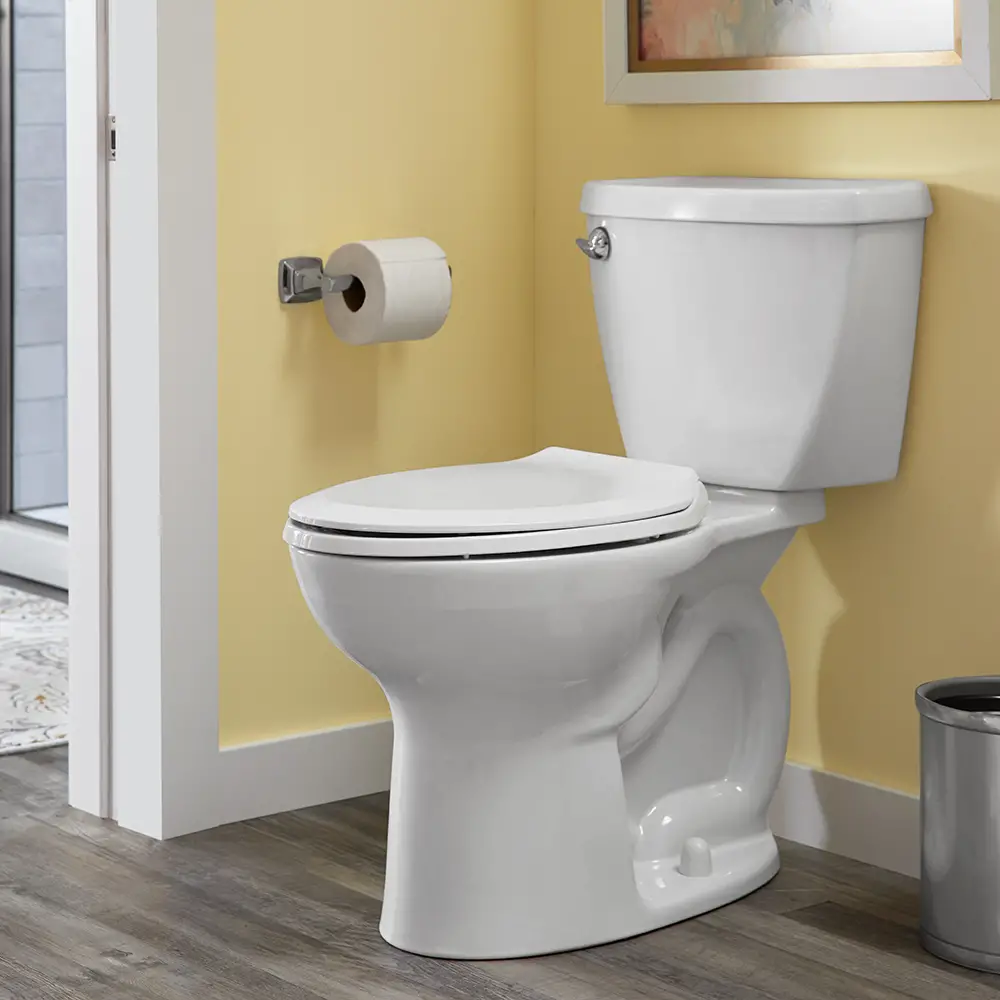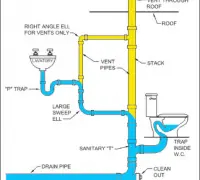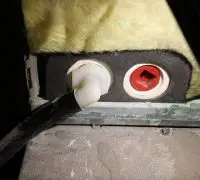Even if it’s not a significant problem, discovering that the toilet is leaking at the base is no good news. Toilets leak for many reasons and you shouldn’t stress a lot if you have a leaky toilet. More often than not, you don’t even need to hire a professional plumber to see why your toilet is leaking at the base.
Page Table of Contents
Start with a test!
First thing first, you need to make sure that the toilet is leaking from the base and it’s not just condensation on the toilet bowl that you see/feel. The last thing you want is to remove the toilet only to discover that you didn’t have a toilet leaking at all.
Begin with soaking up the water with paper towels and flush the toilet. An open water supply line or a damaged shutoff valve could also cause the water pooling on the bathroom floor.
What can cause toilet leaks at the base?

Knowing what causes the leak at the toilet base can help you solve the problem faster. Once you discover the cause of the leak, you can get to the hardware store for supplies and materials. Let’s examine the most common factors causing water leaking at the toilet’s base:
Condensation on toilet collects on the floor
You don’t need to be an experienced plumber to assume that a toilet leak inside could cause excess water at the toilet’s base. The moisture-laden air may condense on the exterior of the toilet bowl/toilet tank. Moisture turns into drops that go down the tank/bowl and collect on the bathroom floor and at the base of the toilet. It happens a lot if there’s a temperature difference between the room and the water in the tank. Such leaks occur when the toilet is constantly running and cause complications when not managed.
To solve the problem, you will need to divert or decrease condensation. You can warm the bathroom, add an exhaust fan or a drip tray right under the tank. If the running toilet is causing condensation, you need to fix the toilet.
Warning
A loose or cracked flange can also cause water around the toilet’s base. Such plumbing problems require attention from professionals.
Faulty Toilet Seal Leaks Water
There is a wax ring underneath the toilet that seals the toilet’s base against the closet flange and the top of the sewer pipe. A loose or damaged wax ring will leak water from the toilet’s base. Sometimes, the wax seal was inappropriate to begin with. You will have to remove the toilet, clean the flange, and put a new rubber seal as a toilet leak barrier.
Warning
As you try to replace the seal, you might discover that the flange is broken/cracked. If so, you will have to hire a professional for repair work.
Toilet Is Loosely Attached
Tee bolts are used to attach the toilet to the floor. They are attached to the plastic/metal closet flange and the flange is attached to the floor around the sewer pipe’s top. The bolts become loose after a long time. Simply tightening the bolts can fix the leaking water around the base of your toilet. If the seal on the toilet is loose or leaking, you need to replace it to improve the leaking from the base.
Toilet Tank and Bowl Are Loose
Most toilets include a lower bowl and an upper tank. The tank is attached to the bowl with plastic or brass bolts and a connector (mack washer). On the other hand, some models are just one-piece as they have a built-in tank and bowl. If you cannot remove it, the leakage cannot be between the bowl and the tank.
For most toilets, the tee bolts continue to get loose in time. The O-ring gasket between the bowl and the tank may also crack or become loose. You can enhance the attachment between the two elements by tightening the bolts. Should the gasket be faulty, you can replace it with a new gasket.
Sometimes, the bolts have rusted, so you need new tee bolts altogether.
Safety Considerations
Water seeping from the toilet’s base is dirty water. Always put on latex gloves when working with the toilet. Use a disinfecting solution to clean up after working around a leaky toilet.
What tools do you need to fix the toilet properly?

No matter the cause for your leaking toilet, you will need:
- adjustable wrench
- latex gloves
- clean towels
- bucket
- putty knife
- tank to bowl gasket
- plastic toilet bolts and nuts
How to Replace a Faulty Toilet Seal
What you need:
- silicone seal or thick wax seal to fix the toilet seal.
Here are the steps to take when the wax seal requires replacement:
Turn the water off
Please turn off the water valve below and unscrew it from the toilet. Flush the toilet too.
Drain the toilet
Use a towel to soak up leftover water from the bottom of the toilet bowl.
Remove Nuts from Floor Bolts
The floor bolts should have plastic caps that you can remove with pliers.
remove toilet
Loosen the toilet from the floor by wiggling it. Lift it straight up and place it aside.
Scrape off Wax Ring
Pull off the failing wax ring at the base of the toilet. Use a putty knife to scrape every old wax residue from the floor closet flange. Wax rings are crucial to creating a water-tight seal at the base of your toilet.
Apply New wax Ring
Stick the new wax ring onto the base of the toilet, centering it around the drain hole. If you use a silicone ring, you need to place the ring on the floor closet flange. W it a few hours until the base solidifies.
Place the toilet back in its place
You have to insert new floor bolts in the closet flange– the threads should face upward. P ace the toilet right down on top of the new bolts. You also have to add the nuts for the floor bolts and use pliers to tighten them.
Don’t forget to reattach the water supply tube. Make sure that the supply line connects to perfection. T rn on the water supply tube and allow the water tank to fill up before you flush it.
How to Limit or Control Bathroom Condensation
What you need:
- insulation panels
- tank drip tray
- bathroom exhaust fan
Controlling the condensation in the bathroom is a more complex process, so you need time, patience, and tools to do it.
Install a Bathroom Exhaust Fan
If there is no exhaust fan in the bathroom, you have to set up a fan appropriate for your bathroom’s size. If the fan doesn’t move enough air, you might need to switch to a higher-capacity fan. Either way, turning on the fan when using the bathroom prevents water from turning into drops.
Equalize Temperatures
A hot bathtub or hot shower in a cold bathroom makes condensation build up in no time. It happens very often with cold materials such as porcelain toilets. If you run the heater in the bathroom, the elements inside will warm up and bring them closer to the temperature of the bathtub or shower.
Add a Toilet Tank Drip Tray
The toilet tank drip is a waterproof plastic tray that you can place between the toilet tank and the toilet bowl. Condensation from the tank will collect in the drip tray and stop it from dripping. Y can only use the drip tray for the toilet tank.
Add Tank Condensation Liner
Tank liners are rolls of thin foam to place on the inside of the toilet tank. They will adjust the temperature of the water in the tank. They’re also good at reducing the noises inside the tank. You need to turn off the water supply line for the toilet, lift the lid, and allow the tank to dry. Use scissors to cut the liner.
How to Tighten Floor Toilet Bolts

What you need:
- Tank-to-bowl gasket
- Plastic toilet tank bolts and nuts
Remove Plastic Toilet Bolt Caps
Start by removing the plastic covers on the toilet base. You can use a screwdriver, a nail file, or you can squeeze the cap to detach it.
Tighten Floor Bolt Nuts
Tighten the tee bolts if the toilet wiggles side to side. Use some pliers to grip the nut and a clockwise motion for tightening. Do it gently so that you don’t crack the porcelain base.
Wiggle Toilet
Wiggle the toilet after gripping its rim. It shouldn’t move when the nuts are tight enough.
How to Tighten a Loose Toilet Tank
Tighten Tank Bolts
Loose tank bolts can cause the toilet to leak. See if the two plastic nuts hold the tank to the bowl and tighten them. Dry off the toilet to see if the toilet is still leaking at the base. If the toilet leaking problem isn’t solved, you will need to replace the tank-to-bowl gasket.
Empty Toilet Tank
Turn off the water supply to the toilet and flush it. Also, disconnect the water supply line from the tank.
Remove Tank Bolts and Tank
Turn out the plastic tank nuts and place the bolts aside. Place one hand inside the tank to hold the tee bolts and use the other to turn it.
Replace Tank-to-Bowl Gasket
Use a clean rag to clean the base of your toilet and insert a new gasket in the center of the drain hole. It should be positioned correctly for the best results.
Tighten Tank Bolts
Put the plastic tank bolts back in place and screw them from below. Put the toilet tank lid back in place. Turn on the water after reattaching the water supply line. Flu h the toilet after the tank has been refilled.
The Caulk Question
Many people don’t know if they should caulk around the base of the toilet. Many plumbers don’t caulk as it can hide any leaks. Some local building codes do require homeowners to caulk around the toilet to stop bacteria from causing unpleasant smells. You need to use a mildewproof tub-and-tile caulk if you decide to caulk.


